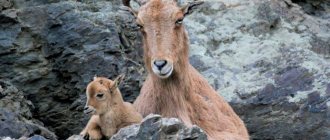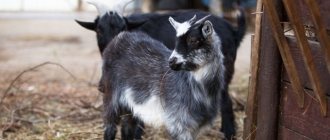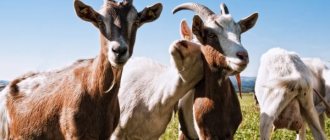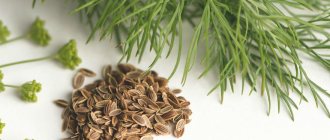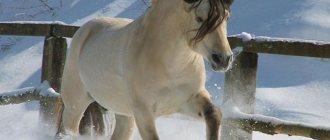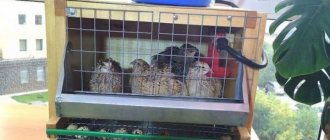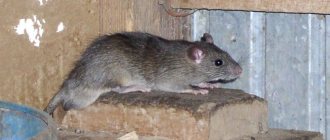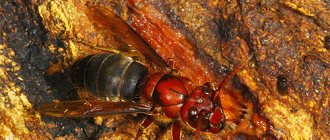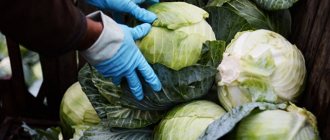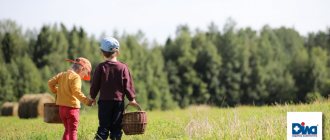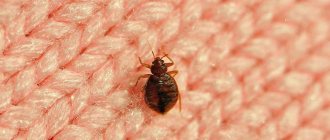6 minutes to read the article
PhotoVideoComments
Probably each of us remembers the children's song about a horned goat, but in nature there are also hornless representatives of the goat tribe. Horns are, first of all, a means of protection and self-defense; in the process of domestication of animals, the need for them disappeared. In this article, we will understand the differences between a polled goat and a horned goat, and also get acquainted with hornless breeds.
Polledness is the congenital absence of horns in cattle.
Origin
For a long time, breeders worked to deprive these animals of their hereditary characteristic - horns. This was done in order to eliminate injuries within the herd, as well as to make it easier for owners to care for their pets. Goats can also become polled after birth by cauterizing their small horns. The procedure is performed for babies whose age does not exceed 14 days. The main condition is that the horns remain in the skin before they have time to erupt.
The hornlessness of a kid is determined as follows: the thumb is placed on the horny tubercles. If the skin is mobile during palpation and circular movements, the animal is polled. If the horny tubercle cannot be felt at all, the cub is also hornless.
Interestingly, with the increase in the number of polled individuals, the number of hermaphrodites in the offspring increased.
Purchasing a goat
When selling, you can also tell about the breed of the goat, and there is actually a lot of room for creativity. Once upon a time I called about an advertisement for the sale of a goat, and they very professionally and sensibly told me that:
- My goats will have a nutmeg-smelling milk after being coated with this.
- The kids will be born true milking goats and will produce up to eight liters of milk per day.
- The goat, with its high-breeding, will ennoble the barn and activate a wave of good fortune that awaits me immediately after purchasing this wonderful animal.
- All the unmarried women in the area will love me, because the smell of a goat will awaken an unearthly passion in them and remove the crown of celibacy.
I then very politely thanked the seller, or rather the saleswoman - she was very kind and wanted to sell her animal. However, the expression “up to eight liters” implies both 1 liter and 3 or 4 liters, which is quite normal and common for goats with traces of the Saanen or Czech breed.
The topic of the crown of celibacy scared me a little, and the depth of my interlocutor’s knowledge about such things confused me, and I politely said goodbye. So if anyone is interested in a wave of luck, eight-liter goats with nutmeg and all kinds of crowns, then buy the right goat, and everything will start right away.
Milok the goat gnaws on a pine branch
However, you can always snort a purebred goat, even the seventh water on jelly, over time, sooner or later there will be someone willing to give the money. The main thing is that the price is not at all exorbitant, and the goat at least slightly has the color of some common goat breed.
It’s generally difficult for me to understand why people buy a goat. He is either his own, selected, or an exchange, also selected. If I had three or five goats, it would be easier and more profitable to take them to the most massive, prominent mongrel goat in the area than to specifically buy a goat. There will always be options for inexpensive prices, even for a chocolate bar with a cake and a bag of oats. Another plus is that you can talk to the owner, sit, drink tea and hear all sorts of stories.
Distinctive features
- Small body.
- Narrow forehead.
- Calm character. In the pasture, they usually give way to their horned counterparts.
- Strong attachment to the owner.
- Relatively easy birth.
- Poor health compared to horned representatives.
- Common infertility in goats.
- More male goats are born than female goats.
- Born goat kids may show signs of a hermaphrodite.
- They take a long time to eat on pasture compared to horned animals.
Hornless individuals have a calmer character; in the herd they give way to their horned counterparts.
Polled goats require careful hoof care because the hoof horn is less strong than their counterparts.
Polledness is most often characteristic of dairy goats. However, when hornless and horned individuals are kept together, the amount of milk produced by the latter will be greater. Next, we will consider the main polled breeds.
What determines the choice of an odorless dairy goat breed?
Some animals are unable to withstand temperature changes or certain climate conditions.
Goat milk is highly beneficial
Other breeds require keeping exclusively indoors. Under improper housing conditions, animal productivity is significantly reduced.
This is what makes choosing dairy goats difficult. It is advisable to first familiarize yourself with the characteristics, breed standards and characteristics inherent in young livestock.
For cultivation, it is necessary to select local subspecies of small ruminants. During their life, they managed to adapt to the climatic conditions of the surrounding area.
Also, the gastric microflora in small animals can lead to some problems with feed digestibility when changing the diet. Therefore, it is advisable to take animals that are adapted to feed on local pastures. This eliminates the risk of dysbacteriosis.
Keeping goats that have adapted to the conditions of the surrounding area is cheaper than breeds brought from other places. Animals are able to graze in the summer on any free pastures.
Thus, there is no need to purchase combined and roughage feeds required for the standard. For the winter diet, it is possible to harvest locally cut grass.
White Saanen
Appeared in the 19th century and is home to the Saanental Valley, located in the Swiss Alps. These goats appeared in Russia even before the October Revolution and took root here very well. Breeders love them for their ability to adapt to harsh climatic conditions. When purchasing a purebred breed, it is important to pay attention to the following external signs: the weight of males reaches 100 kg, females - 90 kg with a height of 90 cm. The coat is short, does not require cutting, the color is most often white (in rare cases - cream), sometimes there are small spots on the udder or on the skin. They have a strong build, voluminous chest, straight strong legs; The animal's muzzle is narrow, with a wide forehead and a small beard. The Saanen breed is characterized by erect ears with small “earrings”; hanging ears are a deviation from the standards.
Interestingly, representatives of this breed can be either horned or polled. Most often, animals arriving from Germany and Poltava do not have horns. When crossed with other species, polledness is the dominant trait.
Individuals are capable of producing 3-4 liters of milk per day after the first lambing; with age, milk yield increases to 8 liters. The lactation period usually lasts 11 months a year. At the same time, the product is distinguished by its relative fat content (4%), taste, and lack of a specific odor.
Nutrition
Saanenki do not like hay made from various grasses at all. They prefer legumes and cereals. In winter, breeders with extensive experience advise feeding goats with brooms, which are collected from willow twigs, birch, linden and oak leaves.
They should not be fed whole grains; it is better to buy ground or crushed grains for goats.
Feeding Saanen goats must be balanced, and therefore it must be supplemented with vitamins.
Preferably natural, for example:
- Apples.
- Carrot.
- Cabbage;
- Beet.
- Potato.
Snow White Swiss goats need bran, preferably in the form of a gruel with potatoes and food waste.
Czech
Bred by breeders not very long ago; the weight of females is 55 kg, males - 80 kg with a height of 75 to 85 cm, respectively. The animal's muzzle is triangle-shaped, while the ears are small; Color varies from milk chocolate to dark brown. An individual feature is a black stripe running along the ridge. They have an external resemblance to a dog. These goats are affectionate, obedient, and often respond to their names. In a year, one individual can produce up to 1,000 liters of milk of medium fat content, which has no foreign flavors. Goats do not have a specific smell, the animals have good health and high fertility. A significant drawback of the breed is heat intolerance.
Representatives of the Czech breed are hornless, have good health, high fertility and productivity.
When choosing a goat, you should pay attention to the udder: when filled, it looks like a silk bag, when emptied, it has noticeable folds.
How to choose?
The choice should be made slowly, based on the purpose for which the goat is needed. For breeding animals, it is important to know the pedigree.
The selection of males is carried out according to such basic characteristics as the number of offspring and indicators of their quality:
- productivity in the chosen direction: the amount of milk, meat, wool and their quality indicators;
- fertility of females of the selected breed: some always have one baby per lamb, while others have five;
- for dairy breeds, a large udder with convex, conspicuous veins and well-developed nipples is important;
- When purchasing an adult, you should know its age and health status.
Lamancha
Brought out by American breeders in the 50s of the last century. They owe their name to the Spanish province of the same name, which became their place of origin. It is based on Alpine, Saanen, Toggenburg and Nubian goats. The animals are of average weight and height (in females the height at the withers does not exceed 71 cm, in males – 76 cm). The wool is soft and smooth, its color can be different. A distinctive feature is small ears, which are divided into two types: corrugated (the size does not exceed 2.5 cm) and dwarf (from 3 to 5 cm long).
Among the individuals there are both polled and horned ones. Females of this breed have average milk yield, the milk does not have any foreign taste, its fat content is 4%. The nature of the animals is calm, they quickly become attached to the owner.
Numerous tribe
Goats are one of the first domestic animals with a long history of serving humans - 9000 years. According to the productive direction, they are divided into 5 groups: wool, down, meat, dairy and mixed (wool, down, meat and milk). On every continent there are representatives of the small-horned tribe for various purposes. In Southeast Asia, goats are mainly raised for meat; downy goats frolic in the Altai Mountains. In Europe, dairy goat breeds are predominantly bred. They are kept not only by the population for milk and for preparing products from it. There are many goat farms here that supply raw materials to food industry enterprises. For others, their specialty is raising goats for sale. Selection experiments continue to improve the quality of milk and the constitution of animals, and to breed new breeds.
Let's look at breeds of dairy goats - the most productive and more adapted to cold winters than the African Nubian goats. These are Saanen, Toggenburg, Alpine (Swiss, French, British), Mingrelian and Gorky dairy goats. The photo of each representative is accompanied by a list of exterior characteristics and characteristics of productivity.
Nubian
This name was given because the main gene pool was taken from the Republic of Namibia. They belong to large breeds: the height at the withers reaches 90 cm, the weight of females is 80 kg, males – 100 kg. The body of the animal is long and elongated. As a rule, females are polled, while males have small horns at birth. The calling card of the Nubians is their long, soft ears that hang downwards. Pregnancy is often multiple (2-3 cubs); in one year, the female is able to give birth 2 times. Lactation occurs almost year-round; milk has a special taste, its fat content is about 8%.
Valued for their gentle, friendly nature. Many breeders note their excessive pampering and inability to adapt to cold climatic conditions. Goats do not have a specific smell.
Care and maintenance
Good housing conditions are the key to high milk productivity. Goats require a balanced diet, which should include green feed, dry grass, vegetables, grains, etc. Although some breeds can produce a lot of milk even on a meager diet, it is better to take care of a variety of feeds so that the animals get everything they need substances.
Often it is necessary to introduce fertilizing into the diet. Goats should be kept in a warm barn, protected from drafts.
Straw or hay can be used as bedding. In the warm season, goats should be turned out for grazing. This reduces feed costs. Good care can increase the rate of weight gain in young animals.
Toggenburg
The homeland of these animals is the valley of the same name in Switzerland. Representatives of this breed are small: height at the withers reaches 70 cm, weight of females - 45 kg, males - 90 kg. Goats, as a rule, are polled, goats are horned, but there are exceptions. Individuals are endowed with a long neck, straight back and convex ribs. The coat is silky, growing up to 20 cm along the back and hips. The color of the animal is brown, and the shades can be different. A distinctive feature is 2 wide parallel white stripes located on the head.
In the Toggenburg breed, goats are usually polled, and goats are horned, but there are exceptions.
The lactation period lasts no more than 9 months. An individual can produce up to 1,000 liters of milk per year, the fat content of which ranges from 4.5% to 8.5%, depending on the correct diet. The product is used to produce premium cheeses. Individuals cannot tolerate heat and dampness; in summer they prefer coolness and shade.
Distinctiveness of color
The Swiss who breed Alpine goats joke that with every goat they get a “multi-colored gift” - these are the colors the kids are born. The classic colors are “white neck” - the head and up to the middle of the body are white, and the rest is gray or black, or “red neck” - brown head-neck-shoulders and black hindquarters. There are variegated (white spots on a black background and vice versa), brown with black spots, brown with a black stripe along the ridge and black legs. There are also such goats - black from the head to the middle of the body, and then white to the tail. Pure white color and brown are not considered for the Alpine goat breed - this color is characteristic of the Saanen and Toggenburg breeds.
Alpine
Among them there are polled and horned representatives. As a rule, the animals are large - the height of females at the withers is 76 cm, males - 81 cm, weight - 61 kg and 77 kg, respectively. The animal's muzzle has a straight profile, its ears are erect; the neck is long and straight. There are different colors: white, gray, brown, etc. Milk production is quite high (they produce from 1,200 to 1,600 liters per year). The drink has a high protein content (3%) and an average fat content of 5.5%. Goats are indispensable in mountainous areas, although they feel good in a stall; They strive to show leadership qualities in the herd, they are quite friendly towards the owner, and love affection.
Breeding
Important Recommendations:
- The minimum period between lambing and the next insemination must be at least 6 months;
- If you don't have a buck in your herd, artificial insemination can be used;
- The release of females is carried out 2 months before goatling;
- The minimum age of a goat suitable for fertilization is 1 year. The most successful age is considered to be 15-16 months;
- Mating takes place only when the female herself wants a goat; forced insemination is unacceptable;
- After covering, it is advisable to remove the goat from the female's stall;
- During the first 3-3.5 months of pregnancy, the goat can be milked. Then, little by little, you need to increase the frequency and volume of milk yield, until lactation stops.
For the last one and a half to two months, you need to stop milking the goat so that it can rest and recover, otherwise the offspring will be born weakened.
Comparative table of breeds according to main criteria
When buying a dairy goat, take into account the quantity and composition of milk, milk yield indicators. Table to help with clarity:
| Breed/indicator | Lactation period, days | Annual milk yield, l | Milk fat content, % | Specific smell |
| Saanen | 330 | 1120 | 3,3 | + |
| Lamancha | 330 | 1013 | 4 | + |
| Nubian | 315 | 814 | 3,7 | — |
| Czech browns | 365 | 950 | 5,5 | — |
| Gorkovskaya | 270 | 450 | 4,8 | + |
| Russian whites | 225 | 500 | 4,2 | — |
| Cameroonian | about 125 | 1.5 l per day | up to 6.0 | — |
Price
The cost of an ordinary goat is slightly lower than the cost of a goat, because a more or less dairy goat can produce about 600-700 liters of milk per season, or even up to a thousand. In prices of commercial products - about twenty thousand, with the price of milk being 30 rubles per liter.
Goats get along just fine without a goat
An adult two-year-old goat will produce 25 kilograms of meat - ideally, costing about five thousand on a good market day. Usually, the average animal will gain half as much by the year. The offspring of an ordinary goat will not necessarily be completely bad; it can be anything, including outstanding.
For my region, the price of a two-year-old goat is about four thousand, with a live weight of forty to fifty kilograms.
Goats in a herd
The loyalty of adult goats is in every way higher than the loyalty of an adult goat. Goats with kids form a herd, and goats, when they reach a certain age, do not mind living a little outside the herd; sometimes they graze separately. In addition, the goat must be kept separate from the milking goats and care must be taken not to cover the young goats outside the plan. That's why it always takes time to make a goat.
Polled goat. Photo from veterantv.com
I sometimes wonder what would happen if the goats all grew into adult animals. To mature adult animals. How would the herd change? Would the animals go into the forest forever? The herd of females and cubs is well managed and lives only for the benefit of the owner. Adult bucks in numbers equal to goats can change the behavior of the herd.
On serious sheep farms, as far as I know, young animals are separated not only from adults, but also by gender. This must be done to avoid early gestation (pregnancy) in order to allow the sheep to grow to a normal size.
Winter goats
People don't need goats in principle. You need to cover goats once a year, and you can get by with one selected goat for three dozen goats. There is less meat from a goat than from a ram. Goats in captivity do well without goats and are quite happy with themselves. Recently I watched a video about artificial insemination of small cattle, and this practice is being introduced on large goat farms in our country.
Selection
Real pedigree goats with selection and a brilliant pedigree are available only from breeders with large herds, in which there are at least more than two hundred animals, so that there is some material for selection - that same selection. It is worth paying more for such a goat than for a goat. But such goats are not sold in newspaper advertisements. Sometimes there is a line for them.
If the seller does not have a more or less large herd, but only ten or fifty goats, then it is somewhat difficult to call him a breeder, rather an enthusiast and amateur. Just like me, basically.
Another goat. Photo from wiktionary.org
Over the entire period of time, my goats gave birth to more than eighty kids, about half of them were goats, and only one of them was truly more or less large and impressive - from almost good parents. I think that out of three hundred goats it would be possible to select a real sire. And such activity over the course of decades leads to the emergence of new productive breeds.
There is a sustainable strategy for improving the herd of purebred goats. It is believed that raising several generations of goats with high-breeding males is very productive as a result. I watched a video about a goat farm near Moscow, and the owners there adhered to this strategy. I read about this in books, including Soviet ones.
Goat meat
Goat meat is excellent meat for up to eight months, up to a year, and as the animal ages, it becomes somewhat tough and sinewy. The same goes for lamb, it is tasty and valuable until the animal is older than one and a half years. However, middle-aged goat or lamb can be used for stew - quite a good option. I have experience in cooking a wonderful stew from a three-year-old goat, and all the tasters were satisfied.
Goat meat tastes like veal and is excellent when cooked and fried. I don’t distinguish lamb from goat meat, but there are people who do, and I know them. Goat meat can be marinated in kefir, vinegar with onions and apple juice. You can also dry the meat by cutting off the fat first. It oxidizes during the process and gives a specific taste. Any meat is dried without fat.
